576i vs 480p: Which Should You Get In 2023?
-
 Written by:
Kristy Roger
Written by:
Kristy Roger
- Last Updated:
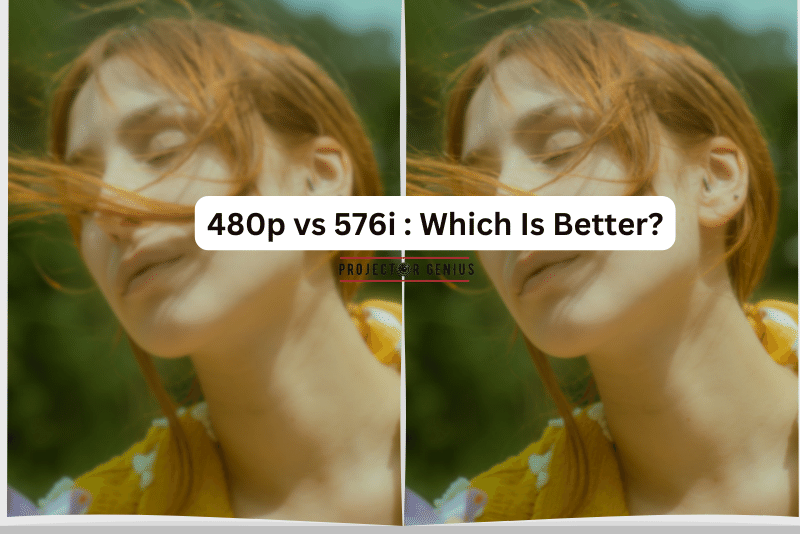
Are you feeling uncertain about the difference between 576i vs 480p?
This article discusses 576i vs 480p and gives you a better understanding.
576i vs 480p?A 480p projector has a resolution of 720×480 pixels in a progressive scan format, offering slightly better image quality than a 576i projector, which has a resolution of 720×576 pixels in an interlaced format. While the difference may not be dramatic, the 480p projector generally provides a smoother and more detailed image for most content.
I recommend using the Table of Contents to quickly access the information you need.
My article is designed to cater to home cinema users of all levels, from Beginners to Advanced enthusiasts.
Table of Contents
576i vs 480p: What is the Difference Between 576i and 480p?
The primary difference between 480p and 576i lies in their scanning methods and resolutions.
480p, which stands for 480 progressive scan lines, uses a progressive scanning method. Each frame of the video is drawn in a single pass, from top to bottom, resulting in a smoother and more fluid motion. The resolution for 480p is typically 640 pixels horizontally and 480 pixels vertically.
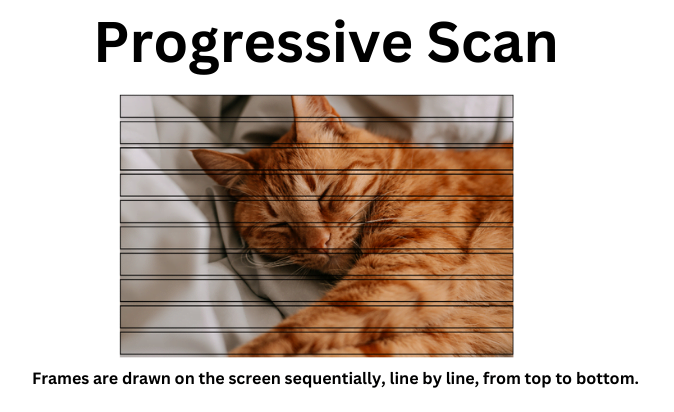
On the other hand, 576i stands for 576 interlaced lines. It employs an interlaced scanning method, where each frame is divided into two fields. The odd lines are drawn in one area, and the even lines are illustrated in the other.
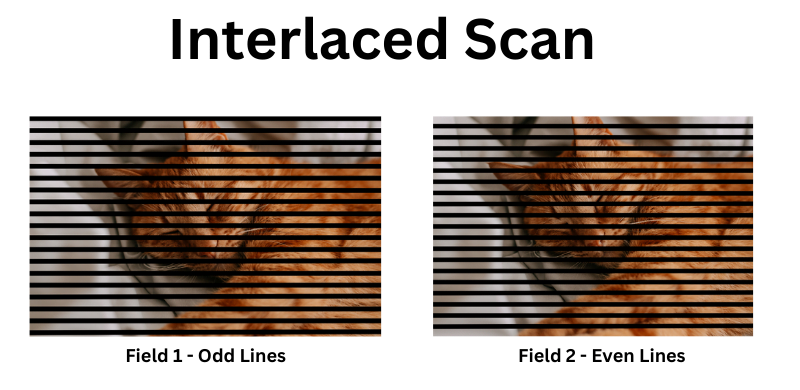
These fields are then interlaced to create a full frame. This method was standard in older analog television systems and can sometimes lead to visible flickering or artifacts in fast-moving scenes. The resolution for 576i is typically 720 pixels horizontally and 576 pixels vertically.
In summary, 480p uses a progressive scanning method and has a resolution of 640×480 pixels, while 576i uses an interlaced scanning method and has a resolution of 720×576 pixels. The choice between the two formats depends on the display technology and the source material being used, as each has its own advantages and limitations in terms of visual quality and motion rendering.
How Does an Aspect Ratio Vary Between 480p and 576i?
The aspect ratio remains the same for both 480p and 576i resolutions. Both formats have a 4:3 aspect ratio.
The aspect ratio is the proportion of the width to the height of the video frame. A 4:3 aspect ratio means that for every 4 units of width, there are 3 units of height. This aspect ratio was common in older television systems and is often referred to as “standard” or “fullscreen” aspect ratio.
So, whether it’s 480p or 576i, the aspect ratio remains 4:3, indicating that the width of the video frame is 1.33 times the height. This aspect ratio was widely used in traditional television sets before the advent of widescreen formats like 16:9.
Which is Better for Movies, 480p or 576i?

Between 480p and 576i, 480p is generally considered better for watching movies. This is because 480p uses progressive scan, which displays each frame in a single pass from top to bottom, resulting in smoother and more fluid motion. The higher vertical resolution (480 pixels) of 480p also contributes to a clearer and more detailed image compared to 576i.
In contrast, 576i uses interlaced scanning, which may introduce visible flickering or artifacts, especially in fast-moving scenes. The lower vertical resolution (576 pixels) of 576i can also lead to slightly less clarity and detail compared to 480p.
While both formats belong to standard definition and have a 4:3 aspect ratio, 480p provides a more visually pleasing experience for movie watching due to its progressive scanning method and higher vertical resolution.
However, it’s important to note that both resolutions are considered outdated in modern high-definition viewing environments, where higher resolutions like 720p, 1080p, or even 4K are commonly used for a superior movie-watching experience.
Compatibility Between 480p and 576i Devices?
480p and 576i devices can be compatible to some extent, but the level of compatibility depends on the specific devices and their input/output capabilities.
Most modern devices that support standard-definition resolutions, such as older CRT (Cathode Ray Tube) TVs, DVD players, and some older gaming consoles, can handle both 480p and 576i signals. These devices often have composite or component video inputs, which can accommodate both resolutions.
However, some older devices or certain types of equipment may only support one of these resolutions. For example, a DVD player that only supports 480p output may not be compatible with a CRT TV that can only accept 576i input.
To ensure compatibility between 480p and 576i devices, it’s important to check the specifications and supported resolutions of each device. Additionally, using appropriate video cables and converters can help bridge the gap between different resolutions and ensure proper signal transmission between devices.
It’s worth noting that both 480p and 576i resolutions are considered outdated in modern entertainment systems, and most current devices and displays support higher resolutions like 720p, 1080p, or even 4K for a better viewing experience.
480p vs 576i, Impact of Refresh Rate on Image Quality?
When comparing 480p and 576i resolutions, the impact of the refresh rate on image quality becomes an essential factor to consider.
Refresh rate refers to the number of times per second the image on the screen is updated. It is measured in Hertz (Hz). A higher refresh rate means more frequent updates, resulting in smoother and more fluid motion, especially during fast-paced scenes or when there is motion on the screen.
For both 480p and 576i resolutions, the image quality can be noticeably affected by the refresh rate. A higher refresh rate, such as 60Hz or 50Hz, can improve the visual experience by reducing motion blur and judder.
However, the impact of refresh rate on image quality might be more pronounced in the case of 576i. Since 576i uses interlaced scanning, it may introduce visible flickering and interlacing artifacts during motion. A higher refresh rate can help alleviate these issues to some extent and make the image appear smoother.
In contrast, 480p’s progressive scan method already provides smoother motion compared to interlaced scanning, even at lower refresh rates. Nevertheless, increasing the refresh rate can still enhance the overall viewing experience by reducing motion-related artifacts.
In conclusion, both 480p and 576i resolutions can benefit from a higher refresh rate to improve image quality, but the impact may be more noticeable for 576i due to its interlaced scanning method.
Clarity Comparison Between 480p and 576i?
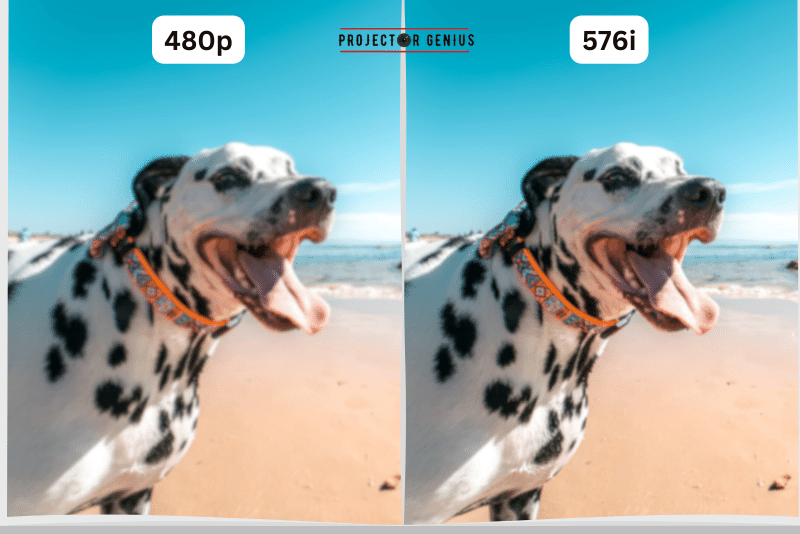
In terms of clarity, 480p generally provides a clearer and more detailed image compared to 576i.
The clarity of an image is affected by the resolution and scanning method. 480p has a higher vertical resolution of 480 pixels compared to 576i, which has 576 visible lines. This means that 480p can display more lines of pixels vertically, resulting in a sharper and more defined picture.
Additionally, 480p uses progressive scan, where each frame is drawn in a single pass from top to bottom. This progressive scanning method eliminates interlacing artifacts and delivers a smoother, more stable image, especially during motion. On the other hand, 576i’s interlaced scanning may introduce visible flickering and interlacing artifacts during fast-moving scenes, reducing overall clarity.
While both 480p and 576i belong to the standard-definition category and have a 4:3 aspect ratio, the combination of higher resolution and progressive scanning in 480p contributes to a more visually appealing and clearer image quality compared to 576i. However, it’s important to note that both resolutions are considered outdated in modern display technologies, where higher resolutions like 720p, 1080p, or 4K have become the standard for achieving greater clarity and image sharpness.
Gaming Experience in 480p vs. 576i Projectors?
When it comes to gaming experience, 480p projectors generally offer a better and more enjoyable gaming experience compared to 576i projectors.
Gaming requires smooth and fluid motion to ensure an immersive and responsive experience. 480p projectors, with their progressive scan method and higher vertical resolution of 480 pixels, provide a smoother image rendering during gaming. The progressive scanning eliminates interlacing artifacts, resulting in a clearer and more stable picture, especially in fast-paced and action-packed games.
On the other hand, 576i projectors use interlaced scanning, which can introduce visible flickering and interlacing artifacts during gaming, leading to a less smooth and somewhat distracting experience.
Moreover, many modern gaming consoles and devices output video signals in progressive scan formats like 480p, making them better suited for compatibility with 480p projectors. While some gaming consoles and devices might support both 480p and 576i, the overall gaming experience is generally smoother and more visually appealing when using 480p projectors.
In conclusion, for a better gaming experience, 480p projectors are preferred over 576i projectors due to their progressive scan technology, higher resolution, and compatibility with modern gaming devices. However, for the best gaming experience, higher-resolution projectors with 720p, 1080p, or even 4K capabilities are recommended for their superior image quality and visual performance.
Is 480p High Quality?
480p is considered to be a standard-definition resolution and was once considered relatively high quality for its time, especially during the early days of digital media and DVDs. However, in the context of modern display technologies and content standards, 480p is no longer considered high quality.
480p has a resolution of 640×480 pixels, which is suitable for smaller screens and older CRT televisions. It can still provide a decent level of clarity and detail for certain types of content, especially when viewed on smaller screens or from a distance. For example, on small computer monitors or portable devices, 480p may still be acceptable for some purposes.
However, as high-definition (HD) and ultra-high-definition (UHD) resolutions like 720p, 1080p, and 4K have become standard, the visual quality and level of detail offered by 480p are noticeably lower in comparison. HD resolutions provide much more clarity, sharpness, and detail, making the viewing experience more immersive and enjoyable, especially on larger screens.
In summary, while 480p can still be considered acceptable for specific applications or older devices, it is no longer considered high quality by modern standards. HD and UHD resolutions have become the norm, providing significantly higher image quality and definition for a more enjoyable and engaging viewing experience.
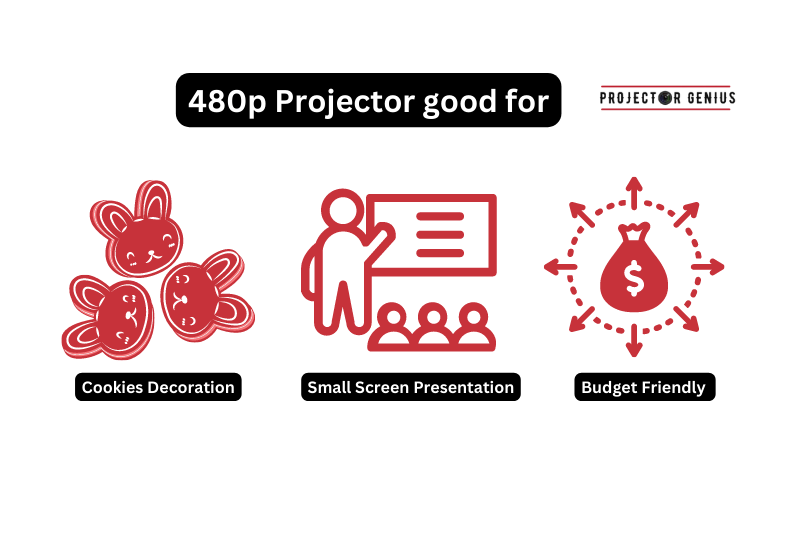
What is 576i Used For?
576i projector is typically used for displaying standard definition video content. The “576i” resolution refers to a video format with 576 lines of vertical resolution and interlaced scanning. The “i” stands for interlaced, which means that the image is displayed in two passes – odd lines are displayed first, followed by even lines. This was a common video resolution used for traditional television broadcasts and DVD playback.
Given that the resolution is relatively low by modern standards, a 576i projector might be used for specific purposes where high-resolution or high-definition visuals are not required. Some potential uses include:
Legacy Content Display: If you have older video content in standard definition format, a 576i projector can be used to display it without upscaling or distortion.
Budget-Friendly Setup: 576i projectors might be more affordable than higher-resolution alternatives. They could be used in situations where cost is a significant factor, such as in temporary setups or community events.
Education and Training: In some educational or training settings where high-resolution visuals aren’t crucial, a 576i projector could still be suitable for displaying instructional videos, presentations, or basic graphics.
Basic Home Theater: While modern home theaters typically use high-definition projectors for better image quality, a 576i projector might be used in smaller spaces or casual setups where the visual experience is less critical.
Simple Digital Signage: For basic informational displays in public spaces, a 576i projector could be used to show announcements, schedules, or simple advertisements.
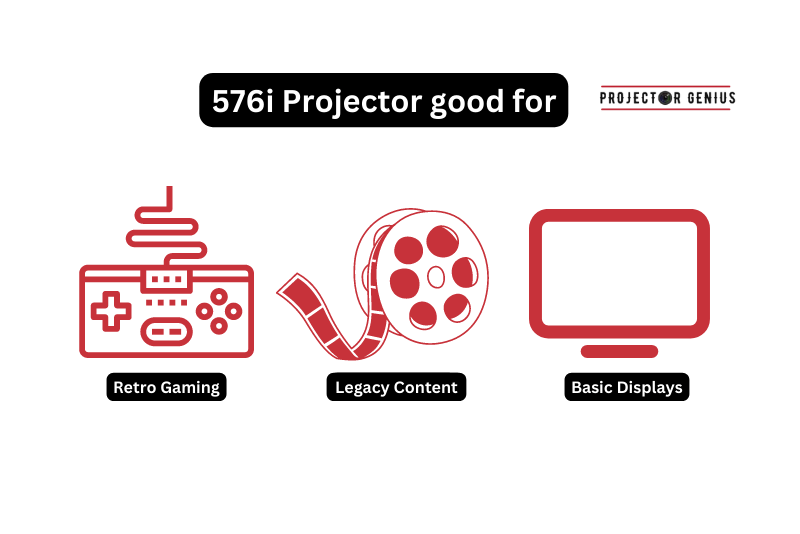
What is 625 Lines 576i?
In the context of video resolutions, “625 lines 576i” refers to a specific standard-definition television resolution that was commonly used in certain regions.
The “625 lines” part of the description indicates the total number of horizontal lines that make up the video frame. This resolution was widely adopted in regions that followed the PAL (Phase Alternating Line) television system, including most European countries, Australia, and parts of Asia. The PAL system has 625 horizontal lines, out of which 576 lines are visible, while the remaining lines are used for various technical purposes like synchronization.
The “576i” part of the description indicates the scanning method used for the video signal. The “i” stands for “interlaced.” In an interlaced video signal, each frame is divided into two fields. The odd-numbered lines are drawn in one field, and the even-numbered lines are drawn in the other. These fields are then interlaced to create a full video frame. Interlacing was a common method used in older analog television systems, but it could introduce visible flickering or artifacts during fast-motion scenes.
So, in summary, “625 lines 576i” describes a standard-definition television resolution used in PAL regions, with 576 visible lines and an interlaced scanning method. This resolution was common for analog television broadcasts, DVD video quality, and some older video gaming consoles in PAL regions. However, it is now considered outdated, and most modern display technologies and content are based on high-definition resolutions like 720p, 1080p, or 4K.
Is 480p the Lowest Resolution?
No, 480p is not the lowest resolution available, but it is one of the lowest resolutions commonly used in modern display technologies.
The term “resolution” refers to the number of pixels that make up the image on a screen. The higher the resolution, the more detailed and clearer the image. Some of the common resolutions used in modern devices include:
480p (640×480 pixels) – Standard-definition (SD) resolution, commonly used in older CRT televisions, DVDs, and some older gaming consoles.
576p (720×576 pixels) – Another standard-definition resolution, used in some PAL regions for television broadcasts and DVDs.
720p (1280×720 pixels) – High-definition (HD) resolution, commonly used in HD television broadcasts, video streaming, and gaming.
1080p (1920×1080 pixels) – Full HD resolution, widely used in TVs, monitors, and content streaming platforms.
4K/UHD (3840×2160 pixels) – Ultra High-Definition resolution, used in high-end TVs, monitors, and media content.
There are even lower resolutions, such as 360p or 240p, used for specific purposes like low-bandwidth video streaming or older mobile devices. However, they are less common in modern applications.
It’s important to note that display technologies continue to evolve, and higher resolutions are becoming more prevalent. While 480p is one of the lower resolutions, it is still considered outdated in the context of modern devices and media content, where HD and UHD resolutions have become the standard for better visual quality and clarity.
Is 480p Enough for Netflix?

Netflix does support streaming in 480p resolution. However, it’s important to note that 480p is considered standard definition (SD), and the video quality might not be as sharp and detailed as higher resolutions like 720p, 1080p, or 4K.
Whether 480p is enough for Netflix depends on individual preferences and the devices being used for streaming. Here are some factors to consider:
Device and Screen Size: If you are streaming Netflix on a smaller screen, like a smartphone or a small tablet, 480p might be sufficient, and you may not notice a significant difference in quality compared to higher resolutions. However, on larger screens like TVs or computer monitors, the lower resolution might be more noticeable and less satisfying.
Internet Speed: Lower resolutions require less bandwidth, so if you have limited internet speed or a data cap, 480p could be a practical choice to avoid buffering or exceeding data limits.
Content: Some content on Netflix might be visually more appealing in higher resolutions. For movies, Outdoor, TV shows, and nature documentaries, higher resolutions can enhance the overall viewing experience and provide more detail and clarity.
Personal Preferences: Some viewers may prioritize the convenience of lower-resolution streaming, while others might prefer the improved visual quality of higher resolutions.
Since Netflix continuously updates its platform and offerings, it’s always a good idea to check the latest information on supported resolutions and streaming options directly from the Netflix website or app. Additionally, your viewing experience will depend on the available internet speed, device capabilities, and the resolution settings you have chosen in your Netflix account.
Does 480p Look Good on a 4K Projector?
No, 480p content does not look good on a 4K projector.
A 4K projector has a native resolution of 3840×2160 pixels, which is four times the resolution of 1080p (1920×1080 pixels). When you play 480p content (640×480 pixels) on a 4K projector, the projector has to upscale the image to fit the higher resolution. Upscaling involves interpolating additional pixels to fill in the gaps between the original pixels, but this process cannot add true detail that was not present in the original content.
As a result, 480p content upscaled to 4K can appear blurry, pixelated, and lacking in detail. The image quality will not match the true 4K resolution that the projector is capable of displaying. The larger the screen size, the more noticeable these shortcomings become.
To get the best image quality on a 4K projector, it’s essential to use content that matches or is close to the projector’s native resolution. High-definition (HD) content, such as 1080p or even better, native 4K content, will provide a more satisfying and immersive viewing experience with superior detail, sharpness, and clarity.
What is the Max 480p Resolution?
The maximum resolution for 480p is 640×480 pixels. This resolution is commonly referred to as “VGA” (Video Graphics Array) and is part of the standard definition (SD) category for video resolutions.
In a 480p resolution, there are 640 pixels horizontally and 480 pixels vertically, resulting in a total of 307,200 pixels that make up the image on the screen. This resolution was widely used in older CRT televisions, DVDs, and some older gaming consoles.
As technology has advanced, higher resolutions like 720p, 1080p, and 4K have become more common for better image quality and visual clarity. 480p is considered to be an outdated resolution in the context of modern display technologies, but it may still be used for specific purposes, especially in older devices or for content that was originally recorded in this resolution.
Final Thoughts
480p and 576i resolutions offer differing visual experiences due to their distinct scanning methods and pixel configurations. 480p’s progressive scan with a resolution of 640×480 pixels results in smoother motion and clearer images compared to 576i’s interlaced scanning and 720×576 pixel resolution.
While both resolutions belong to the standard-definition era, they have become outdated in modern display technologies where higher resolutions like 720p, 1080p, and 4K are now commonplace. The choice between 480p and 576i depends on specific devices, content compatibility, and personal preferences, but both resolutions have been surpassed by HD and UHD resolutions that offer superior image quality and visual clarity.
Author of this Post:

Kristy Roger
Home Cinema Consultant & Tech Enthusiast
Holding a background in Industrial and Electrical Technology from the University of Alberta, Kristy has spent 5+ years consulting on home theater products at a top electronics firm. As a certified Technical Professional with Lean Six Sigma credentials, Kristy expertise ranges from projector nuances to hands-on experience with leading models. Kristy have been sharing her knowledge online for two years, blending professional insights with personal experiences from her own home cinema setup. Off the screen, She is a dedicated mom to Jerry, Ryan, and our two pups, Cuddle and Paw.



